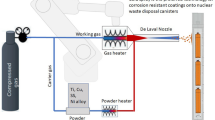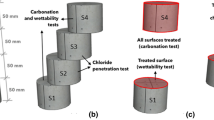Abstract
Exposures of concrete and selected coating materials to tritiated atmospheres have shown that tritium sorption on these materials and subsequent desorption are important parameters in defining tritium sources within a tritium-handling facility. Exposure time, tritium concentration and humidity of the air atmosphere affected the amount of tritiated water vapor sorbed. Some of the selected coatings reduced the tritium sorbed to less than 1% of unprotected concrete samples.
Similar content being viewed by others
References
R. S. Dickson (1990). Tritium Interactions with Steel and Construction Materials in Fusion Devices, Canadian Fusion Fuels Technology Project Report CFFTP G-9039 (AECL-10208), and references therein.
R. S. Dickson and J. M. Miller (1992). Sorption of tritium and tritiated water on construction materials.Fusion Technol.,21, 850–855.
J. M. Braun and A. S. Williamson (1985). Permeability of protective coatings to tritium.Fusion Technol.,8, 2312–2317.
F. Ono, S. Tanaka, and M. Yamawaki (1992). Sorption and desorption of tritiated water on paints.Fusion Technol.,21, 827–832.
F. Ono, S. Tanaka, and M. Yamawaki (1992). Sorption of tritiated water on organic materials and subsequent desorption.Fusion Technol.,21, 1964–1967.
R. A. Jalbert, S. J. Bereton, and D. F. Holland (1986). Contamination of aluminum and painted surfaces exposed to tritium.Fusion Technol.,10, 1223–1227.
S. Numata and H. Amano (1988). Tritium Permeation into Concrete, Fusion Technology 1988. inProceedings of the 15th Symposium on Fusion Technology, Utrecht, A. M. Van Ingen, A. Nijsen-Vis, and H. T. Klippel (Elsevier, Amsterdam, 1988), 1260–1264 pp.
S. Numata, H. Amano, and K. Minami (1990). Duffusion of tritiated water in cement materials.J. Nucl. Mater.,171, 373–380.
S. Numata, H. Amano, and M. Okamoto (1990). Tritium inventory in Portland cement exposed to tritiated water vapour.J. Nucl. Mater.,171, 350–359.
P. A. Finnet al. (1983). The wall tritium concentration as a factor in fusion reactor hall design.Nuclear Technol./Fusion,4, 389–394.
S. Numata, Y. Fuji, and M. Okamoto (1991). Simulation of cleanup of tritiated water in fusion reactor-size concrete enclosures.Fusion Technol.,19, 466–472.
S. Tanakaet al. (1989). Simulation of soaking effect in air detritiation system.Fusion Eng. Design,7, 353–361.
J. M. Miller, J. A. Senohrabek, and P. J. Allsop (1992). Tritium Sorption on Protective Coatings for Concrete, Canadian Fusion Fuels Technology Project Report CFFTP-G-9198 (AECL-10707).
K. Y. Wonget al. (1991). Tritium decontamination of machine components and walls.Fusion Eng. Design,16, 159–172.
L. Rodrigoet al. (1992). Tritium measurement and monitoring in experimental and process systems with ionization chambers.Fusion Technol.,21, 629–635.
Author information
Authors and Affiliations
Additional information
Work funded by AECL Research and the Canadian Fusion Fuels Technology Project (CFFTP).
Rights and permissions
About this article
Cite this article
Miller, J.M., Deschenes, L.L. & Senohrabek, J.A. Tritium sorption on concrete protective coatings and the impact on operational safety. J Fusion Energ 12, 59–64 (1993). https://doi.org/10.1007/BF01059356
Issue Date:
DOI: https://doi.org/10.1007/BF01059356




